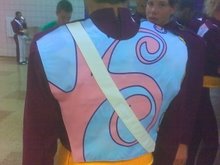Competition...blessing or curse - Part 1 - Drum Corps
Drum Corps - Intro to Competition
*note: I focus specifically on Junior Corps in these discussions because of the types of corps, it is the most visible, popular, and has the most heated competition between units. Most of the arguments and observations made can also apply to other types of competitive corps.
The heart and soul of Drum Corps is rooted in competition, and therefore it is only appropriate to first look at the history of this competition. Both the make-up and the nature of competitive drum corps have evolved over the years. In the early days, local drum corps would compete in parades and field shows against neighboring corps. The participants were all local kids from the surrounding town, county, or neighborhood playing to a mostly local audience. Corps were evaluated based upon strict, military-like inspections focused upon appearance and uniformity. They competed in events sponsored by the VFW and American Legion - however there was nothing really close to a formal governing body for any type of standardization in the activity. In 1971, directors from several major drum corps formed Drum Corps International (DCI) to be a national governing body for the activity. They continued to use the style of judging known as the "tick" system to evaluate performances. This system, used until 1983, deducted points from a corps' score based upon "mistakes" judges would observe in the corps performance. While this has the appearance of being objective, the standards by which something is considered a mistake varied from judge to judge. Little or no creative thought was given to programs in those days because the judging was almost entirely focused on error detection.
After 1983, DCI changed the judging to a qualitative "build-up" system where corps were rewarded with points for a combination of execution and content. This opened the doors for modern drum corps to experiment with complex show designs that would have never came about in the "tick" era. Designers freely experimented with new music and visual techniques that moved the activity more towards the theater than the military. In fact, some of the most successful shows of this era were based upon theatrical productions (West Side Story, Les Miserables, Phantom of the Opera to name a few. Recently, questions of the subjectivity of this style of judging have come to light as show designs have almost moved past the point of any objective comparisons and are, in fact, hurting the evolution of the activity.
This, of course, leads me to the ultimate question of these posts - does competition in Drum Corps improve or hurt the activity? I will examine this question using the standards I outlined before.
Attendance/Fans
Drum Corps fans can be broken down into three categories; the hard-core fans, the casual fan, and the "bando". The hard-core fans are the fans who actively seek and support the activity in multiple aspects of their lives. These are mostly people who have marched at one time, or have thrust themselves into the activity in more ways than observing. This can include, online discussion boards, blogging, volunteering, donations, teaching, administrative work, and by many other means. These fans have a personal connection to the activity and are very defensive of their viewpoint about how it should be approached.
The casual fan is differentiated from the hard-core fan by being more passively involved with the activity. This group comprises most of those people who have not marched and who do not have a personal interest in the activity. They are generally contented to observe the activity as it is presented to them focusing mainly on personal enjoyment and entertainment. These fans encompass the spectrum from moderately interested in the activity, to those in the general public who may be seeing their first show.
The last group are the "bando" fans. These are the students enrolled in band at the high school or college level that revere the activity as the "major leagues" of marching arts. Their attitude is generally of reverence for the technical skill and creative complexity corps can achieve through their performance. Their tastes vary wildly and are often extremely pliable to others opinions. While sometimes the most naive of the fans, they are also some of the most emotional and enthusiastic supporters of the activity. These fans can directly relate to the performers and therefore have a different perspective on the modern activity than do the other types of fans.
Now that the fan categories are defined, let us examine trends in the drum corps fans support over the years in terms of competition. The hard-core fans are in it for the long haul. They have much invested in this activity and are not going to simply drift away. It also takes quite a bit to anger a hard-core fan and lose them completely. Most likely, these fans will follow the activity in some fashion under pretty much any circumstance. These people most likely got into the activity by becoming involved in the excitement of competition and therefore, competition has no bearing on their support. The"bando" fans are also not likely affected by competition because their admiration for corps are more based upon performance skill than competitive placement.
The wild-card in discussion of competition and fans lie within the last group, the casual fans. These people have a large range of motivations for observing drum corps and therefore there is no one clear causal thread for all of them. Seeing as Drum Corps evolved as a competitive enterprise, these fans are almost surely aware of this aspect of the activity. All of these fans may be aware of it, however, they may not understand it. To them it may seem a silly thing akin to attempting to judge two Broadway shows, or compare several orchestral pieces. This is one potential obstacle for the activity breaking into mainstream culture. The casual fan may be more willing to accept the activity if pretenses of competition were dropped completely and there was more a focus on entertainment.
However, there are examples of activities that combine the creative and evaluative modes successfully in mainstream culture. One needs to look no further than figure skating or ice dancing to see what I mean. While it can be argued that the competitive nature of these activities limits their appeal in the same manner as it does in drum corps, it is easy to see their fanbase is rooted more in the mainstream than that of drum corps (it is an Olympic sport, its placement on prominent broadcast TV, its international appeal).
The best than can be said of competition's effect on attendance and fan base is that it creates excitement and interest for the dedicated fans. At worst, competition has no measurable effect on this aspect of Drum Corps.



No comments:
Post a Comment